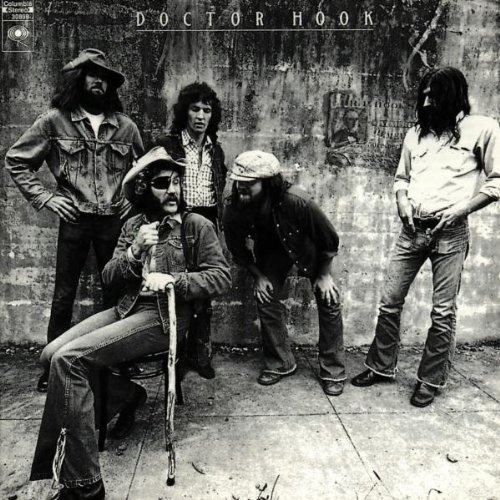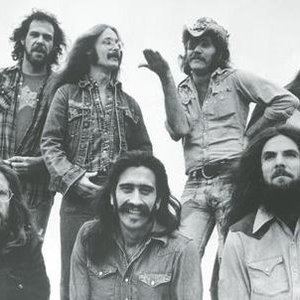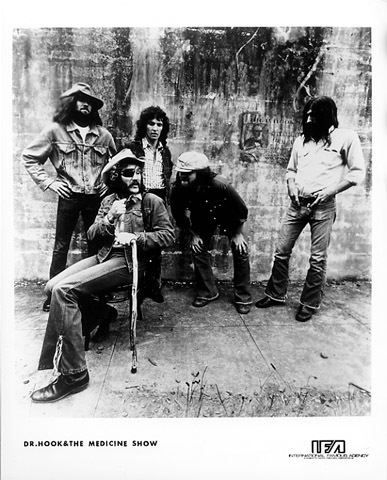Also known as Dr. Hook | Years active 1967–1985 | |
 | ||
Past members Billy FrancisRay SawyerGeorge CummingsBobby DominguezJimmy "Wolf Cub" AllenDennis LocorrierePopeye PhillipsJoseph OlivierJohn "Jay" DavidRik ElswitJance GarfatJohn WoltersBob 'Willard' HenkeRod SmarrWalter HartmanNancy NashCarol ParksKeith AustinMo Thaxton Origin New Jersey, United States (1967) Members Profiles | ||
Dr. Hook & the Medicine Show, shortened from 1975 onwards to Dr. Hook, were an American rock band, formed in Union City, New Jersey. They enjoyed considerable commercial success in the 1970s with hit singles including "Sylvia's Mother," "The Cover of Rolling Stone," "Sharing the Night Together," "A Little Bit More" and "When You're in Love with a Beautiful Woman." In addition to their own material, Dr. Hook and the Medicine Show performed songs written by the poet Shel Silverstein.
Contents

The band had eight years of regular chart hits, in both the U.S. (where their music was played on top-40, easy listening and, to a lesser extent, country music outlets) and throughout the English-speaking world, including Canada, Australia and the UK. Their music spanned several genres, mostly novelty songs and acoustic ballads in their early years; their greatest success came with their later material, mostly consisting of disco-influenced soft rock, which the band recorded under the shortened name Dr. Hook.

History

The founding core of the band consisted of three Southerners who had worked together in a band called The Chocolate Papers: George Cummings, Ray Sawyer and Billy Francis. They had played the South, up and down the East Coast, and into the Midwest, before breaking up. Cummings, who moved to New Jersey with the plan of forming a new band, brought back Sawyer to rejoin him. They then took on future primary vocalist, New Jersey native Dennis Locorriere, at first as a bass player. Francis, who had returned South after the Chocolate Papers broke up, returned to be the new band's keyboardist.

When told by a club owner that they needed a name to put on a poster in the window of his establishment, Cummings made a sign: "Dr. Hook and the Medicine Show: Tonic for the Soul." The "Hook" name was inspired by Sawyer's eyepatch and a reference to Captain Hook of the Peter Pan fairy tale, although, humorously, because Captain Hook was neither a doctor nor wore an eyepatch. Ray Sawyer had lost his right eye in a near-fatal car crash in Oregon in 1967, and thereafter always wore an eyepatch. The eyepatch would mistakenly lead some people to believe that Sawyer was 'Dr. Hook'.

The band played for a few years in New Jersey, first with drummer Popeye Phillips (who had also been in The Chocolate Papers), who went on to be a session drummer on The Flying Burrito Brothers' first album, The Gilded Palace of Sin. Citing musical differences, Popeye returned home to Alabama and was replaced by local drummer Joseph Olivier. When the band began recording their first album, Olivier left in order to spend more time with his family, and was replaced by session player, John "Jay" David, who was asked to join the band full-time in 1968.
In 1970, their demo tapes were heard by Ron Haffkine, musical director on the planned Herb Gardner movie, Who Is Harry Kellerman and Why Is He Saying Those Terrible Things About Me?. The songs for the film were written by the cartoonist, poet and songwriter Shel Silverstein. Haffkine determined that Dr. Hook was the ideal group for the soundtrack. With the help of producer Haffkine, the group recorded two songs for the film: Locorriere sang the lead on both "The Last Morning," the movie's theme song, later re-recorded for their second album, Sloppy Seconds, and "Bunky and Lucille," which the band can be seen performing in the film. The film, released in 1971 by National General Pictures, received mixed critical reviews and did only modestly at the box office, but it helped Dr. Hook and The Medicine Show secure their first recording contract.
Ron Haffkine arranged a meeting with Clive Davis, CBS Records described in Davis's autobiography. Drummer David used a wastepaper basket to keep the beat, and while Sawyer, Locorriere and Cummings played and sang a few songs, Francis hopped up and danced on the mogul's desk. This meeting secured the band their first record deal. Subsequently, the band went on to international success over the next twelve years, with Haffkine as the group's manager, as well as producer of all the Dr. Hook recordings.
Their 1971 debut album Doctor Hook featured lead vocals, guitar, bass and harmonica by Locorriere, guitarist Cummings, singer Sawyer, drummer David, singer/guitarist, and keyboard player Billy Francis. The album included their first hit, "Sylvia's Mother." It sold over one million copies, and was awarded a gold disc by the RIAA on August 2, 1972.
Silverstein wrote the songs for many of Dr. Hook's early albums (including their entire second album), such as "Freakin' at the Freaker's Ball," "Sylvia's Mother," "Everybody's Makin' It Big But Me," "Penicillin Penny," "The Ballad of Lucy Jordan," "Carry Me Carrie," "The Wonderful Soup Stone" and more, some of which were co-written with Locorriere and/or Sawyer.
In 1972, the band added a full-time bassist, Jance Garfat, and another guitarist, Rik Elswit. The band's second single, "The Cover of 'Rolling Stone'," which was another million selling disc, from Sloppy Seconds attracted the attention of those who would appreciate their irreverent attitude and stage show. It also got the band on the cover of Rolling Stone magazine — albeit in caricature rather than photograph. The song poked fun at the idea that a musician had "made it" if they had been pictured on the cover of Rolling Stone.
In the United Kingdom, the BBC Radio network refused to play "The Cover of 'Rolling Stone'," as it was considered advertising a trademark name, which was against the BBC's policy. According to Dennis Locorriere some BBC DJs overdubbed the words "Cover of the Radio Times" in place of the "Cover of Rolling Stone" to get around this restriction. The group's next hit, "A Little Bit More," was taken from the 1976 album of the same name. It was written and originally performed by Bobby Gosh. Other hit singles from Dr. Hook included "Only Sixteen" (originally by Sam Cooke) (U.S. number 6), "Sharing the Night Together" (number 6), "When You're in Love with a Beautiful Woman" (number 6) and "Sexy Eyes" (number 5), which featured sexy female backup singers. Save for "A Little Bit More" (number 11), all the singles mentioned above were certified million-sellers. "When You're in Love with a Beautiful Woman" reached number 1 for several weeks in 1979 in the UK. They had another hit single with "Better Love Next Time" (number 12). The band toured constantly but never managed to turn their success with singles into album sales.
The Medicine Show's lineup changed a few more times over the years. When David left the group in 1973, he was replaced by John Wolters. The next to depart was founding band member Cummings, who left in 1975 due to personal and musical differences. The band did not initially replace him. When Elswit was diagnosed with cancer a couple of years later, the band added Bob "Willard" Henke (formerly of Goose Creek Symphony). Elswit recovered and returned to the lineup, but they kept Henke on as well for a while. When Henke left in 1980, they added Rod Smarr.
Sawyer left in 1983 to pursue a solo career, while the band continued to tour successfully for another couple of years, ending with Dr. Hook's One and Only Farewell Tour, with Locorriere as the sole frontman.
Locorriere retains ownership of the Dr. Hook name and uses the name for his current solo band as "Dr Hook Starring Dennis Locorriere;" he continues to tour the world. From 1998 to 2015, Sawyer was granted a license to tour separately as "Ray Sawyer of Dr. Hook" and "Dr. Hook featuring Ray Sawyer;" the two have been on good terms, and Sawyer has not performed publicly since his last tour ended in October 2015. Locorriere omits all direct mentions of Sawyer from the current Dr. Hook Web site, noting: "I assume (he) would not wish to be represented on my site anymore than I would on theirs."
Members
Studio and live albums
(for the 1975 Bankrupt album the band name was shortened to Dr. Hook)
Singles
Songs
Sylvia's MotherBallad of Lucy Jordan · 1975
Sharing The Night TogetherPleasure and Pain · 1978
Sexy EyesSometimes You Win · 1979
